[Annealing Machine Replacement Parts]Essential Guide to Sourcing and Replacing Annealing Machine Replacement Parts: Ensuring Optimal Performance and Longevity
News 2024-9-30
****When it comes to industrial manufacturing processes, annealing plays a crucial role, especially in treating metals and improving their ductility and toughness. However, like any other machinery, annealing machines can experience wear and tear over time, leading to the need for replacement parts. In this article, we will explore the significance of annealing machine replacement parts, how to identify the right components, and some tips for maintaining the proper functioning of these machines.
Understanding Annealing Machines
Annealing machines are designed to heat materials, usually metals, to a specific temperature and then cooling them down in a controlled manner. This process relieves internal stresses and defects within the metal structure, making it more suitable for further manufacturing or processing. The effectiveness of the annealing process is heavily dependent on the precision and functionality of the machine, which is why ensuring that all components are in optimal condition is crucial.
Common Replacement Parts for Annealing Machines
The primary challenge many manufacturers face is identifying which parts may require replacement. Commonly, these components include:
1. **Heating Elements**: These are the core of the annealing heat process. Over time, heating elements can degrade or fail due to thermal stress. Regularly checking the functionality of these elements is critical to maintaining consistent annealing temperatures.
2. **Thermal Insulation**: Insulation materials are essential to maintain temperatures and improve energy efficiency. A breakdown in insulation can lead to significant energy loss and inconsistent heating of the materials.
3. **Control Panels**: Modern annealing machines come with sophisticated control panels that manage temperatures, timing, and other operational parameters. If these panels fail, they can cause operational disruptions.
4. **Fans and Cooling Systems**: Adequate cooling is just as important as heating. Fans and cooling systems ensure that the annealing process operates within the required temperature ranges and helps in quick cooling of processed materials.
5. **Conveyor Systems**: In automated annealing systems, conveyor belts play a key role in material transport. Over time, belts may wear out or become misaligned, leading to operational inefficiencies.
6. **Sensors and Thermocouples**: These devices monitor temperature and other relevant parameters. If they malfunction, it can impact the entire annealing process, making timely replacement vital.
Identifying When to Replace Parts

Essential Guide to Sourcing and Replacing Annealing Machine Replacement Parts: Ensuring Optimal Performance and Longevity
- **Inconsistent Annealing Quality**: If you notice that the materials are not being treated uniformly, it could be a sign that one or more components are malfunctioning. - **Increased Energy Consumption**: A rise in operational costs without a clear reason can indicate that equipment is not functioning efficiently and requires maintenance or repair.

Essential Guide to Sourcing and Replacing Annealing Machine Replacement Parts: Ensuring Optimal Performance and Longevity
Sourcing Replacement Parts
When it comes time to source replacement parts, there are a few avenues to consider:

Essential Guide to Sourcing and Replacing Annealing Machine Replacement Parts: Ensuring Optimal Performance and Longevity
2. **Reputable Suppliers**: It is essential to source parts from reputable suppliers. Look for those who specialize in industrial machinery parts, as they are more likely to have knowledgeable staff and reliable products.
3. **Requesting Technical Specifications**: Before purchasing parts, request the technical specifications to ensure compatibility with your machine model. This preemptive measure can save time and additional costs down the line.
Maintenance Tips for Annealing Machines
Beyond knowing how to replace parts, proper maintenance procedures will extend the life of your annealing machine:
- **Regular Inspections**: Schedule routine inspections to catch issues early on. Look out for wear and tear in critical components like heating elements and insulation.
- **Cleanliness**: Keeping the machine clean can preempt many issues related to overheating and inefficient operation.
- **Documentation**: Maintain a detailed log of parts replacements, repairs, and maintenance activities to identify any repetitive issues that may arise.
In conclusion, ensuring that your annealing machine operates efficiently is critical for optimal performance and longevity. By understanding the importance of replacement parts, recognizing when they need replacing, and sourcing them wisely, manufacturers can maintain a consistent quality in their output while minimizing downtime. Regular maintenance will not only enhance the lifespan of the machine but also improve overall productivity and efficiency in the manufacturing process.
